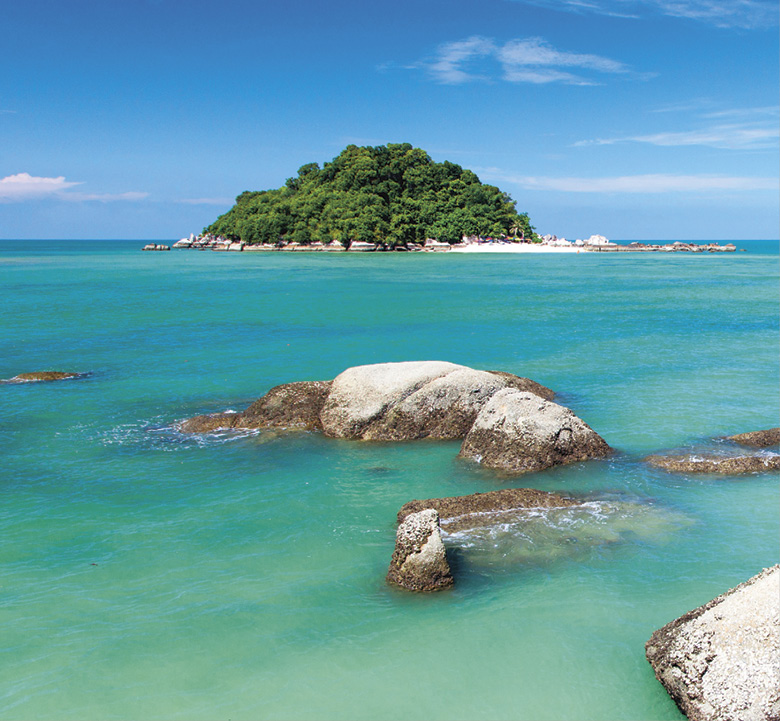It was on the west coast that the British got their first toehold in the Malay Peninsula, and long exposure to colonial influence has made it in many ways the most historical, multicultural and well-developed part of Malaysia today. Nowhere epitomizes this better than the island of Penang, whose capital, George Town, is arguably the most endearing city in the country, a fascinating conglomeration of century-old temples, museums and shophouses that set the backdrop to a modern and thriving art and café scene. Aside from Penang, the west coast’s other major attraction is Langkawi, an island best known for its pricey resort hotels, although it also has plenty of budget places to stay along its southwestern beaches. The only other significant island off this coast, Pangkor, pales in comparison, but offers a more down-to-earth seaside experience.
Over on the mainland, the largest city is Ipoh, an excellent base for visiting Cameron Highlands (also easily reached from Kuala Lumpur), once a British hill station and still a popular refuge from the stifling heat of the plains. Ipoh’s hinterland encompasses a number of attractions, including opportunities to take in Malay royal architecture or indulge in a spot of white-water rafting. Points of interest thin out inland, but it is possible to see the rainforest at the Ulu Muda Eco Park and the Royal Belum State Park, both bordering Thailand, and explore Malaysia’s newest World Heritage Site, the archeologically important Lenggong Valley – though all are tricky to reach without your own transport.
Getting around: THE WEST COAST
By plane Penang has frequent flights to and from many other Malaysian and Southeast Asian cities, notably Singapore. Flights from KL, Singapore and Kuching, among others, serve Langkawi.
By car The west coast’s major artery is the North–South Expressway (also referred to as “NSE”, and north of KL, as the E1). Access to the east coast is mainly via Route 76, which links up with Route 4 (the East–West Highway) to Kelantan state in the northeast.
By bus Frequent express buses link the west coast with KL, the south and Singapore, and the east coast.
By train The West Coast Line operates frequent ETS (Electric Train Service) metre-gauge fast trains between Padang Besar on the Malaysia–Thai border and Gemas in Negeri Sembilan, where the line connects with the East Coast Line to Kota Bharu. Most trains stop at all major destinations, including Alor Star, Butterworth, Taiping, Kuala Kangsar, Ipoh and Kuala Lumpur. There are also two convenient and cheaper KTM Komuter services between Butterworth and Padang Besar, and Bukit Mertajam (15min from Butterworth) to Taiping and Padang Rengas (for Kuala Kangsar).
By boat Langkawi is linked with southern Thailand by ferry, and there are also boat services between Langkawi and Penang, Kuala Kedah and Kuala Perlis.


Pangkor Island
Highlights
1 Ipoh Fast-gentrifying mining city of old, surrounded by intriguing attractions including cave temples and the bizarre Kellie’s Castle.
2 Gopeng This former mining town packs in history, nature, caving and excellent white-water rafting.
3 Pangkor Island Laidback tropical island with some of the best beaches on the west coast.
4 Taiping Traditional town with tranquil gardens and a mini hill station; Malaysia’s largest mangrove reserve lies nearby.
5 Royal Belum State Park Bordering Thailand, this unexpectedly fine nature reserve is a great place to spot Rafflesia flowers.
6 Cameron Highlands Cool down amid the tea plantations and jungle trails of this former colonial hill station.
7 George Town In Penang’s capital, rows of old shophouses, elaborate temples and clan houses perfectly set the scene for an eclectic art and café culture.
8 Langkawi This upmarket resort island on the Thai border features white-sand beaches and a cable car over the forested interior.